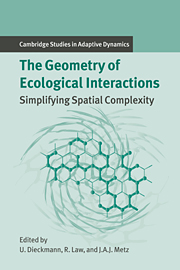Book contents
- Frontmatter
- Contents
- Contributing Authors
- 1 Introduction
- Part A Empirical and Statistical Background: A Plant Ecological Perspective
- Introduction to Part A
- 2 A Neighborhood View of Interactions among Individual Plants
- 3 Spatial Interactions among Grassland Plant Populations
- 4 Spatio-temporal Patterns in Grassland Communities
- 5 Statistical Modeling and Analysis of Spatial Patterns
- Part B When the Mean-field Approximation Breaks Down
- Part C Simplifying Spatial Complexity: Examples
- Part D Simplifying Spatial Complexity: Techniques
- References
- Index
- International Institute for Applied Systems Analysis
3 - Spatial Interactions among Grassland Plant Populations
Published online by Cambridge University Press: 14 January 2010
- Frontmatter
- Contents
- Contributing Authors
- 1 Introduction
- Part A Empirical and Statistical Background: A Plant Ecological Perspective
- Introduction to Part A
- 2 A Neighborhood View of Interactions among Individual Plants
- 3 Spatial Interactions among Grassland Plant Populations
- 4 Spatio-temporal Patterns in Grassland Communities
- 5 Statistical Modeling and Analysis of Spatial Patterns
- Part B When the Mean-field Approximation Breaks Down
- Part C Simplifying Spatial Complexity: Examples
- Part D Simplifying Spatial Complexity: Techniques
- References
- Index
- International Institute for Applied Systems Analysis
Summary
Introduction
The neighborhood perspective on plant interactions discussed in Chapter 2 shows the richness of processes in plant neighborhoods and how difficult it can be to obtain a detailed mechanistic understanding of them. Faced with this dilemma, plant ecologists have sometimes adopted a more phenomenological approach, which integrates over the known (and unknown) mechanisms by which neighbors interact, using a few neighborhood-dependent measures of plant performance. These measures are interaction coefficients, usually thought of as relating to competition between pairs of species.
In multispecies communities, competition coefficients can summarize a lot of information on the effects species have on one another and help ecologists to understand the spatial structures that develop over the course of time. This chapter describes
• how plant ecologists have tried to investigate competition in the field,
• what has been learned about plant competition coefficients from this field work,
• the information available about the structure of matrices of these competition coefficients, and
• how sensitive the outcome of competition is to the initial spatial pattern.
We focus on grassland communities. These communities are almost ideal for studying the significance of spatial pattern for ecological processes because they are patchy and approximately two-dimensional. In fact, the appearance of patchiness is more complicated than it might seem at first. Borders between patches that look well-defined from a distance can turn out to be quite diffuse when viewed more closely. Patches of one species frequently overlap patches of another, and the canopies of different species can be intimately mixed (Watkins and Wilson 1992; Chapter 4), especially in species-rich communities.
- Type
- Chapter
- Information
- The Geometry of Ecological InteractionsSimplifying Spatial Complexity, pp. 28 - 47Publisher: Cambridge University PressPrint publication year: 2000
- 11
- Cited by

